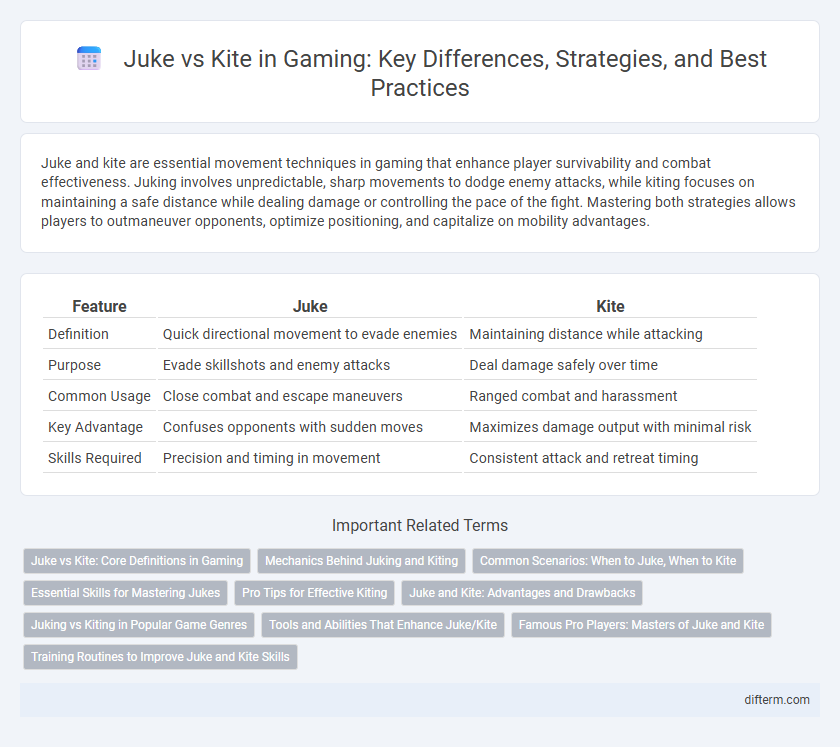Juke and kite are essential movement techniques in gaming that enhance player survivability and combat effectiveness. Juking involves unpredictable, sharp movements to dodge enemy attacks, while kiting focuses on maintaining a safe distance while dealing damage or controlling the pace of the fight. Mastering both strategies allows players to outmaneuver opponents, optimize positioning, and capitalize on mobility advantages.
Table of Comparison
| Feature | Juke | Kite |
|---|---|---|
| Definition | Quick directional movement to evade enemies | Maintaining distance while attacking |
| Purpose | Evade skillshots and enemy attacks | Deal damage safely over time |
| Common Usage | Close combat and escape maneuvers | Ranged combat and harassment |
| Key Advantage | Confuses opponents with sudden moves | Maximizes damage output with minimal risk |
| Skills Required | Precision and timing in movement | Consistent attack and retreat timing |
Juke vs Kite: Core Definitions in Gaming
Juke and kite are key movement strategies in gaming designed to outmaneuver opponents. Juke involves sudden, unpredictable directional changes to evade attacks or confuse enemies, often seen in fast-paced combat scenarios. Kite focuses on maintaining distance while attacking, using hit-and-run tactics to maximize damage output without close engagement.
Mechanics Behind Juking and Kiting
Juking involves rapid, unpredictable directional changes to evade opponents, leveraging precise timing and muscle memory to outmaneuver attacks. Kiting centers on maintaining optimal distance while attacking, combining movement speed manipulation with ranged abilities to control engagements. Mastery of both mechanics increases a player's survivability and tactical advantage in dynamic combat scenarios.
Common Scenarios: When to Juke, When to Kite
Juking is most effective in close-range combat or tight situations where sudden, unpredictable movements can evade enemy attacks or skill shots. Kiting excels during ranged engagements when maintaining distance is crucial to chip away at opponents while avoiding damage, especially for champions or characters with strong attack or poke abilities. Understanding the terrain and cooldowns can help decide when to juke for quick escapes or when to kite for sustained damage over time.
Essential Skills for Mastering Jukes
Mastering jukes in gaming requires precise movement control and sharp spatial awareness to outmaneuver opponents effectively. Quick directional changes combined with timely animation cancels create deceptive patterns that confuse adversaries. Developing muscle memory through repetitive practice enhances reaction speed, making jukes a vital skill for gaining positional advantage during combat.
Pro Tips for Effective Kiting
Mastering effective kiting in gaming involves maintaining optimal distance from opponents while using terrain to limit their movement. Prioritize precise timing in movement and attacks, utilizing stutter steps and attack resets to maximize damage output without overexposing. Awareness of cooldowns, enemy abilities, and positioning enhances survivability and control during engagements.
Juke and Kite: Advantages and Drawbacks
Juke enhances player survivability by enabling unpredictable movements that confuse opponents, making it difficult to land attacks, which is especially useful in close combat scenarios. Kite involves maintaining distance while attacking, offering sustained damage output but requiring precise timing and positioning, which can be challenging under pressure. The drawback of juke lies in its reliance on quick reflexes and risk of missteps leading to easy kills, whereas kite may expose players to crowd control or gap-closing abilities if not executed properly.
Juking vs Kiting in Popular Game Genres
Juking and kiting are essential maneuvering techniques in popular game genres such as MOBAs, FPS, and battle royale games, where players use juking to quickly change direction and dodge enemy attacks, while kiting involves maintaining distance to attack safely from afar. In MOBAs like League of Legends, juking confuses opponents with unexpected movement, whereas kiting maximizes damage output while minimizing retaliation. FPS titles like Overwatch also reward precise juking for evading shots, and kiting strategies excel in battle royales like Fortnite by combining relentless ranged attacks with strategic repositioning.
Tools and Abilities That Enhance Juke/Kite
Tools and abilities that enhance juke and kite techniques in gaming include mobility skills such as dashes, blinks, and speed boosts, which help players quickly change positions and evade enemy attacks. Crowd control abilities like slows, stuns, and roots enable better control of spacing, making it easier to maintain distance or escape. Items that grant vision denial or terrain manipulation, such as smoke bombs or deployable obstacles, further improve the effectiveness of juking and kiting by confusing opponents and providing safe retreat paths.
Famous Pro Players: Masters of Juke and Kite
Famous pro players like Faker and Uzi have mastered the art of juking and kiting, showcasing incredible agility and game sense in high-stakes matches. Their ability to seamlessly dodge skill shots while maintaining optimal attack range often turns the tide of competitive gameplay. These legends demonstrate how precise movement techniques can dramatically improve positioning and survivability in MOBAs.
Training Routines to Improve Juke and Kite Skills
Effective training routines to improve juke and kite skills involve repetitive drills that enhance agility and directional control, such as cone weaving and shuttle runs. Incorporating reaction time exercises with varying stimuli sharpens decision-making speed and execution during gameplay. Consistent practice with in-game scenarios accelerates muscle memory development, enabling precise jukes and efficient kiting to outmaneuver opponents.
juke vs kite Infographic

 difterm.com
difterm.com